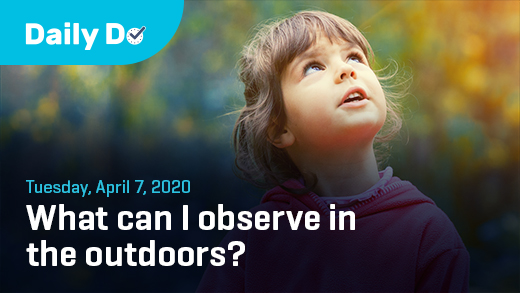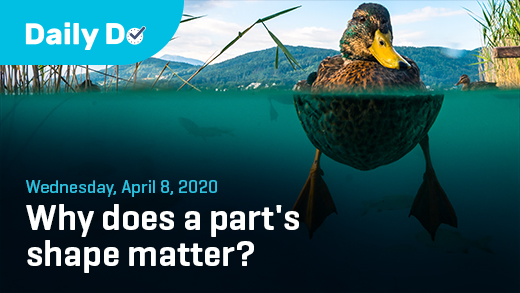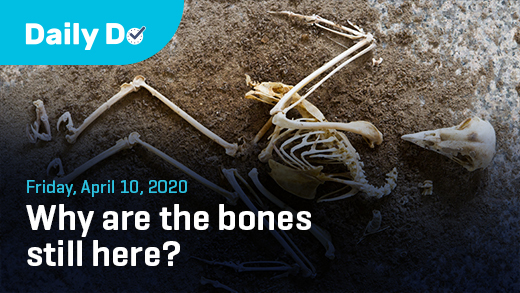Reflecting on this week’s Daily Do
By Korei Martin
Posted on 2020-04-10
Disclaimer: The views expressed in this blog post are those of the author(s) and do not necessarily reflect the official position of the National Science Teaching Association (NSTA).

Another week has passed. Amidst all of the stressors in our new daily lives, let’s take a deep breath together and reflect on students’ opportunities for sensemaking this week. Sensemaking is about actively trying to figure out how the world works. Phenomena (observable events that occur in the universe that we can use our science knowledge to explain or predict) are what students are trying to figure out and engaging in science and engineering practices is how students are able to do it.
In Monday’s Daily Do, How does air make things move?, students analyze and interpret data (science and engineering practice) to make sense of wind blowing leaves around (phenomenon). The following is a short vignette of what this task might look like in home or distance learning (This vignette assumes families have access to the blowing leaves video through a computer or phone.)
The teacher shares the Daily Do with their students’ families and encourages the family to complete the task together sometime in the next three days. The teacher offers to help families get started providing specific days/time when they are available.
An adult or older sibling asks their student(s) to notice and wonder with them as they watch the “Leaves Blowing in the Wind” video. After watching the video two or three times, the family member facilitating the task asks, “What did you notice or wonder?”
Student: The leaves were moving.
Family member: I noticed that some of the leaves stopped and some kept moving.
Student: The big leaves got stuck.
Family member: They dragged on the ground and kind of spun before they got stuck.
Student: But the little leaves didn’t get stuck. Some hit the ground but didn’t get stuck.
Family member: “OK, so big and small leaves are moving, but some big leaves stop moving. Do you think we should investigate why that is happening next?”
Students and their families grab some small objects from around the house like a cotton ball, paper clip, dried bean, and penny. Family members help students make a straw by rolling a small piece of scrap paper into a tube. The family member asks, “What do you think will happen when you use the straw to blow on the things we have on the table? Why do you think so?” The family member listens to their students share their ideas. Students and their family members begin blowing on the objects through the straw, naturally blowing hard and sometimes soft on the different objects. The family member uses the questions provided in the task to help students use firsthand observations to describe pattern and relationships (K-2) in the ways the objects moved using soft blows and hard blows. Using a sentence stem for support, the students figure out, “When I blow softly on something, then it moves but not very far.” In other words, pushes can make objects start moving and can be different strengths (K-PS2.A Forces and Motion).
In the second investigation, students and their families collect and analyze data they can draw evidence from to support another relationship they likely noticed in the first investigation – heavier objects don’t move as far as lighter objects which is the very, very beginning of the idea the greater the mass of the object, the greater the force needed to achieve the same change in motion (MS-PS2.A).
The family member asks, “How is blowing through the straw like the winding blowing outside?” Student responses might include, wind blows soft and hard, wind moves things, things need wind to move. The family member then asks, “Do you think we can use our observations to explain why the big and little leaves are moving, but sometimes the big leaves stop moving?” Students might respond, “They [leaves] move because the wind is pushing on them. The big leaves stop when they don’t get a big enough push.”
Next week we’ll look at a high school sensemaking task.
Below you’ll find descriptions of every Daily Do published this week. As you visit each Daily Do or reflect on one you taught during the week, can you imagine your own students and their families making sense of phenomenon together using science and engineering practices? What support might families need to get started or to keep them excited to try the next sensemaking task if their experience with the previous task didn’t match what was described?
Monday, April 6, 2020 – How does air make things move?

How does air make things move?
Today’s task is geared toward younger children and their families (older siblings are encouraged to participate!) uses wind moving objects around as the phenomenon to motivate science learning. Using familiar objects, students conduct investigations (science and engineering practice) and use the thinking tools of patterns and cause-and-effect to make sense of the science ideas pushes can be big or small and can cause changes in motion.
Today’s task is geared toward younger children and their families (older siblings are encouraged to participate!) uses wind moving objects around as the phenomenon to motivate science learning. Using familiar objects, students conduct investigations (science and engineering practice) and use the thinking tools of patterns and cause-and-effect to make sense of the science ideas pushes can be big or small and can cause changes in motion.
Tuesday, April 7, 2020 – What can I observe in the outdoors?

What can I observe in the outdoors?
Exploring Your Environment (the environment around where you live)
Spring is here! The month of April holds two days dedicated to the environment – Earth Day (April 22) and Arbor Day (April 24) – which traditionally encourage students and their families to get outside and become more familiar with their local environment.
In today’s task, What can I observe in the outdoors?, students and their families take a closer look at their local green spaces by describing the rocks, soil, moving water, plants and animals found there. Noticing the parts (components) of these green spaces (systems) using science and engineering practices and the thinking tools of systems and stability and change (crosscutting concepts), is the first step in understanding how these parts interact in an ecosystem.This task is based on “Exploring Your Environment” published in the NSTA Press BookTeaching Science Through Trade Books.
Wednesday, April 8, 2020 – Why does a part’s shape matter?

Why does a part’s shape matter?
What Makes Them Special eBook
No matter where you live, you see plants and animals everywhere. But did you ever stop to wonder What Makes Them Special? Here’s your chance!
In today’s task, Why does a part’s shape matter?, students-as-scientists observe plants and animals through the special lens of structure and function (crosscutting concept) to figure out how the shape of body parts (feet, beaks, shells, thorns, etc.) is related to the ways plants and animals use them to live and survive. Students-as-engineers use these observations to inspire and inform them as they design solutions to everyday problems they and their families experience.
Thursday, April 9, 2020 – How do our noses smell things?

How do our noses smell things?
In today’s Daily Do, How do our noses smell things?, families participate in a Dinner Table Discussion about the sense of smell.This sensemaking discussion has four parts:
- Families raise the question “How do our noses smell things?” by introducing the phenomenon of being able to smell what’s for dinner (or any meal when the family is together).
- Families ask students to explain what they currently understand about the sense of smell.
- Families prompt students to generate questions about the sense of smell.
- Families read an article together to find some answers to their questions about the sense of smell.
Friday, April 10, 2020 – Why are the bones still here?

Why are the bones still here?
In today’s task….
Today’s task explores a phenomenon many students and their families have probably seen at some point in time – something that was once alive decomposing. Animals outside in the environment die every day. Why Are The Bones Still Here? engages students in science and engineering practices to figure out what happens to these animals that die outside.
This task has been modified from its original design in order to be used by students, parents, and teachers in distance and home learning. While students could complete this task independently, we encourage students to work virtually with peers or in the home with family members.


